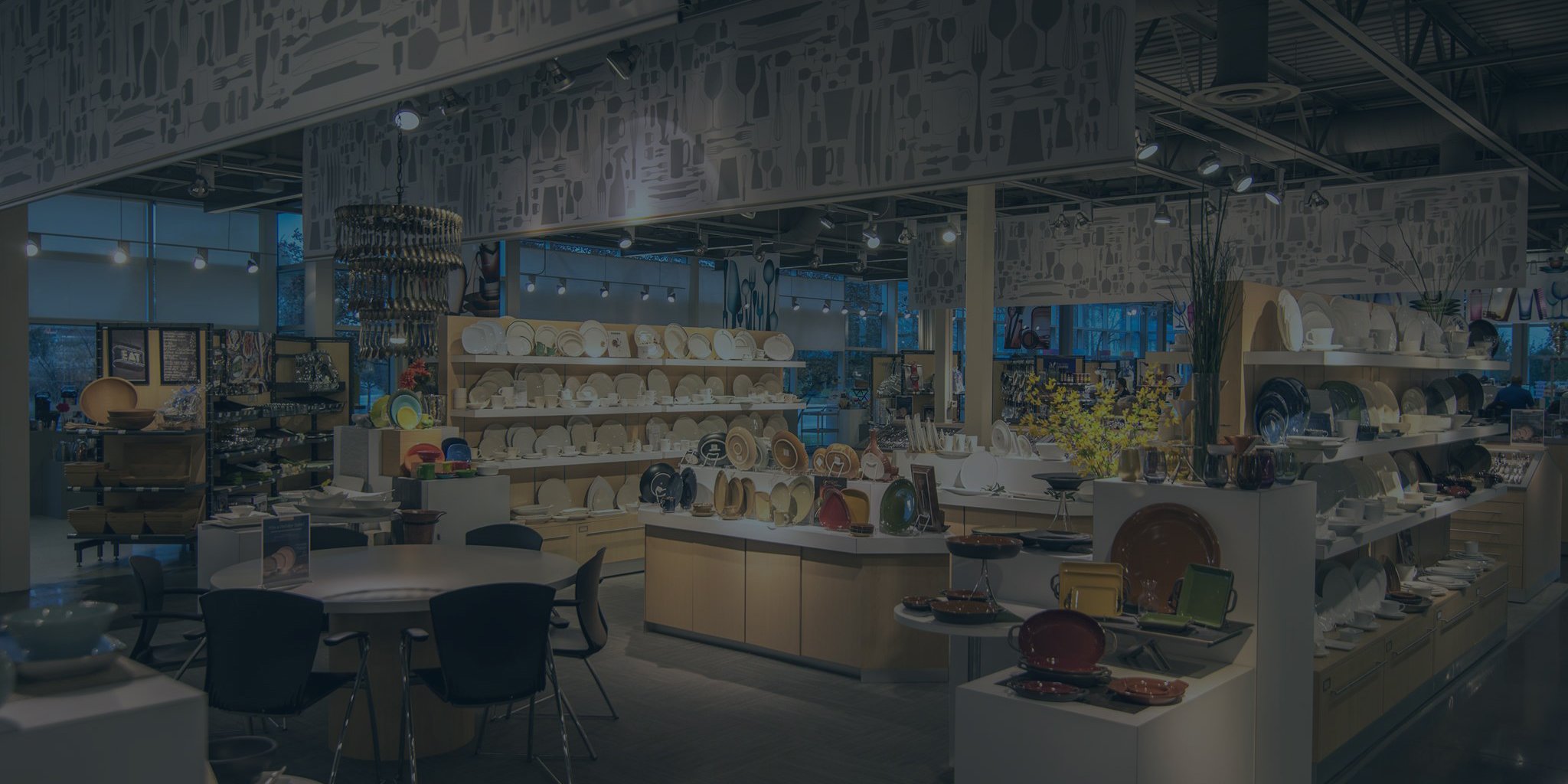Your food is the heart and soul of your business, but how you serve it can be just as important. In this episode, Julie Pandl, Sales and Tabletop Specialist, discusses how a smart, inspired tabletop design can impact your guest experience.
To get started creating the perfect tabletop design, contact us today.
Excerpts
How important is it to include a solid tabletop presence? How much does it play in the overall success of a restaurant after it's open?
Julie: Restaurant owners tend to focus a lot on their back of the house, the
flow, the equipment they need, which is all very important, too. But once the menu is out and you're putting food on the plate, this is what your customer sees. Oftentimes your
tabletop is the first thing they see when they walk in the door.It's an incredibly important consideration and should be folded into menu design, which is typically how we approach it from the get-go. One of the first questions we ask is: What's on the menu? We can help the customer decide what size the plates should be, what they should look like.
Tabletop, china especially, really helps set the stage. It helps reinforce the brand. It helps create the essence of the experience. Your chef is going to put a lot of that into the food, but what the food is sitting on and how your china helps the food pop does a lot to create the experience and reinforce the brand and what you're trying to do.
One of the things we talk about from the beginning is: what type of establishment is it? Is it fast casual? Is it upscale dining? Is it elegant, formal? Is it a country club? Obviously, you want your tabletop to reflect the general atmosphere of the restaurant.
For example, a country club might have a more formal mid-rim plate with a gold band on it, or maybe a logo to reinforce brand. Something that's a little bit more casual might have fun organic shapes, embossing, maybe a little pop of color. There's a lot going on in the tabletop world these days, so there's plenty of things to choose from.
...
How does tabletop help with the restaurant's overall ambiance?
Julie: I'll use the example of a mid-casual restaurant. Let's say it's Italian. You have some unique items on your menu, and you have a very Italian atmosphere. Your tabletop can do a lot in terms of setting the stage for the food. It can do a lot in terms of establishing creativity, whether it's a different shape, a different color, a different texture.
Your flatware can do the same thing. Typically it's actually sitting on the table. Is your flatware going to have a hammered look? Is it going to have a color? Is it going to have a vintage look? These are all things to consider because the customer sees them right away.
Glassware is another thing if you have a wine program. You have a very nice sheared rim glass, that's going to be important if somebody's spending a lot of money on a glass of wine. All these things go into the collective atmosphere of a restaurant.
Your customer's going to see that you put a little love in it. I say that with the food a lot; we can tell when there's a little love in it. The same is true with the overall atmosphere. That includes the tabletop. Your customer's going to notice when you're paying attention to details like that. When it's important to you, they will pick up on it. It will make them feel like they had an overall good experience, a memorable experience, that everything fits together. It should be a seamless back of the house, front of the house feel, when a customer comes in.
I mentioned wine glasses. If you're going to have a wine program, you want to have a nicer wine glass. You want to have something that fits the right wine with the right glass. Something that enhances the aroma and the flavor. Well, this is also an opportunity for you to charge more.
Let's say you decided to have a unique appetizer, and you put it on a plate that's really beautiful, that really makes the food pop, that makes the whole presentation pop. That's an opportunity for you to charge more. It gives you opportunity to increase margin when you're putting a little bit more emphasis on your presentation.
...
Let's look at the bigger picture of this experience from a dining room perspective.
Julie: Obviously, you're putting tabletop on the table, so everything has its consideration. Clearly space is an issue. This is something that will be discussed in the beginning of the process with your designers. Your tables themselves are an issue. What are they going to look like? Are they wooden? Are you going to put a linen on them? What's the look and feel you want to have with the tabletop? How does it weigh into your acoustics?
Mixing and matching is not necessarily a trend that I think is going to stick around for a while. So I don't know that it needs to match, but it needs to have some sort of cohesiveness with your place. If you’re, in general, not mixing and matching, then it's fine. But if you have random things that don't match, I think that's going to be a little awkward.
Your tables, chairs – all those things need to be considered in terms of space for your servers to get through, for your customers to feel comfortable. There's so many things to choose from out there. From top of the line to mid-range to less expensive. It's just a matter of what's going to fit in your establishment and what's going to look right and what's going to create the experience that you want to create.
...
What are your thoughts on chairs versus booths? Does it matter?
Julie: From a personal standpoint, I like the coziness of a booth. They lend themselves very well to conversation. You can put a booth just about anywhere. There's a lot of upscale restaurants that have [booths] that go around the of a restaurant and there's a table and a chair on the other side.
Chairs are a thing that needs a lot of consideration. We want to consider comfort, you want it to be comfortable, but you don't want it to be so comfortable that they never leave. Also, how long do you want it to last? Some chairs are built to last a long longer than others.
...
Do you think presentation can really make or break the experience for a customer?
Julie: I don't know if I would say make or break. I think it's extremely important. Your customer can tell when you're paying attention to detail and your presentation, whether it be with your entree or your salad or your dessert. If you do something that wows them, they're going to remember it.
In the china department, there's so many different patterns out there, different collections that give so many opportunities for that "wow "presentation. I know when I go out to eat, when I see something that's just really put together well, it makes a difference. We eat with our eyes first. The food comes, and you look at it and if it looks good and it's presented well and it's on a pretty plate, you want to eat it and you're going to remember it.
I also think it's important even with wine and beer. If my beer is in a really cool glass, if it comes in the right glass and it has a great nice head on it and it's clean and it's beautiful, I'm going to want to have another one. It offers opportunities to make more sales.
...
Let's talk about choosing china, glass, silverware. How important is that? How many different options are there?
Julie: Again, we would start with menu. That sort of drives everything.
Let's say it's a steak place. You want to make sure that you have the right plate for your signature steak. Whether it's a bright white, wide coupe plate, whether it's got a little embossing on it, you want something where the chef can really show off. You want to give the chef a nice palette.
Flatware is a very touchy-feely decision. Customers come in and I always say to them, "Let's go look, but pick it up. Hold it in your hand. See how it feels." It's very important that the flatware has the right hand feel. It is a very intimate piece of the tabletop because people hold it in their hand, and they put it in their mouth. It has to feel right in your hand in addition to looking right and matching. You want it to match the plate in a way that doesn't have to be matchy-matchy, but it has to at least kind of look right, in order to kind of have a cohesive look on the tabletop.
I would say similar things about the glassware. It's important to shoot for what you're shooting for in terms of branding and ambiance and what the essence of the experience should be. You want to choose glassware in the same vein.
Glassware is driven by a couple of things. What kind of wine program are you going to have? What are your ounce capacities? What kind of beer program are you going to have? People want their glassware to look and feel right, depending on what the brand is. Are you going to have a 7.5-oz. rocks glass, 9-oz. rocks glass and a double old fashioned? Do you want an all-purpose wine glass for your reds and your whites? Do you want a separate special wine for your wine program, for your $75, $80, $100 bottles of wine? Those are all decisions that have to be made.
We're seeing more and more restaurants still use the traditional pint glass for beer, but a lot of restaurants are moving into something a little bit more conducive to craft beer – glassware that's actually designed for an IPA or a wheat beer so that it not only looks better, but it tastes better and you have more opportunities to make more sales.
...
I wanted to get some thoughts from you about working with a tabletop distributor. What are some of the benefits? How important do you think it is for a restaurant owner to have a solid working relationship?
Julie: I come from the end user side. We, as a family restaurant, had very solid relationships with our distributors and took advantage of them all the time.
You as an end user need to spend time developing your restaurant. You need to spend time enhancing your business. You need to spend time making sure your business is on the right track and you're making money. To have somebody that you can utilize who knows things, who is trained on things from equipment to smallwares to tabletop, it's really, really important because it saves you time. It saves you money in the long run.
Your distributor also has relationships with the manufacturers. I work with all of the tabletop manufacturers in the country, so I can negotiate pricing. If there's an issue, I can be the one talking to the manufacturer. If you order your tabletop and something's not right, I can make it right. We work very closely with our manufacturer partners to make sure that everything goes smoothly.
Glassware and china breaks. It's not going to last forever. China manufacturers all have different features and benefits. Knowing what to choose from and having somebody help you decide.
Let's use a little example here. You have a wooden tabletop and it's repurposed whiskey barrel wood. It's got a finish on it, but it might be likely to scratch. You need to go with a plate that's fully glazed on the bottom, because it can slide across the table and not scratch it. Those are things that your specialist will know.
These are all things that your distributor can help you deal with down the road. It's not a one-off situation. When we do a tabletop installation, we're there for the life of the table. We really work hard to make sure that you're getting the right product that's right for your menu, that's right for your restaurant, that's going to stand the test of time.
Want to chat with a tabletop expert? Get in touch!

The Boelter Wire is an episodic podcast that focuses on thought-leadership conversations with industry experts and established partners, and is designed to help listeners evolve their business, stay competitive and pursue their passions.
Subscribe to The Boelter Wire here or on Spotify, Google Play, Apple Podcasts or Amazon Music.
.jpg?width=192&name=BLT_Only_Logo_Black%20(19).jpg)



